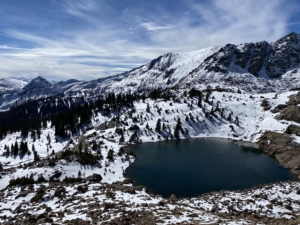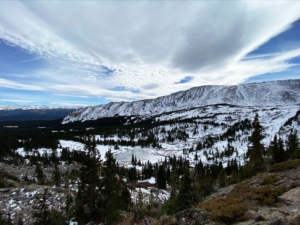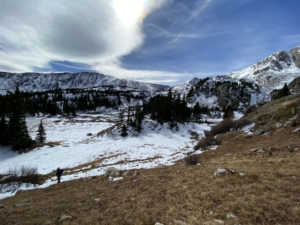Denver Gazette – A ‘holy grail’ of conservation
The Denver Gazette celebrates the Trust’s involvement in the landmark Snowmass Falls Ranch conservation project.
April 1, 2024
The Denver Gazette celebrates the Trust’s involvement in the landmark Snowmass Falls Ranch conservation project.
April 1, 2024
March 22, 2024-
Just 8 miles northeast of the town of Crested Butte, the Queen Basin rises to meet the ridgelines and summit of White Rock Mountain. The basin has a rich mining history, and remnants can still be found scattered throughout it. In 2022 the Trust acquired the 10-acre Copper Glance Lode property, the last private inholding remaining in the basin. Recently we transferred it to public ownership to be added to the Maroon Bells-Snowmass Wilderness.
Through out much of Colorado’s high country, including deep in what today is designated wilderness, traces of mining history can be found, from mine shafts still framed in timbers to bits of rusted machinery and bean cans. The majority of these silver, gold, and copper mines were small-scale, and the landscapes around them have recovered quickly, wiping away most traces of their camps and wagon trails. These small operations were certainly much different than the kinds of mega-mines we see today, removing entire mountain tops and reshaping vast landscapes to access ore. But they still serve as a reminder of what could have been. Had the boom not turned to bust so quickly, or had the lasting protections of designated wilderness not been established 60 years ago, the basins and ridges of Colorado’s high country might have looked much different today, including those surrounding the Copper Glance Lode property.
out much of Colorado’s high country, including deep in what today is designated wilderness, traces of mining history can be found, from mine shafts still framed in timbers to bits of rusted machinery and bean cans. The majority of these silver, gold, and copper mines were small-scale, and the landscapes around them have recovered quickly, wiping away most traces of their camps and wagon trails. These small operations were certainly much different than the kinds of mega-mines we see today, removing entire mountain tops and reshaping vast landscapes to access ore. But they still serve as a reminder of what could have been. Had the boom not turned to bust so quickly, or had the lasting protections of designated wilderness not been established 60 years ago, the basins and ridges of Colorado’s high country might have looked much different today, including those surrounding the Copper Glance Lode property.

Data from the Resilient Landscapes Mapping Tool
Our thinking on what these landscapes provide has also evolved. No longer are they valued primarily for the profit lying beneath their surface, but for their beauty, their recreational opportunities, and the role their ecosystems play in sustaining life. The 10-acre Copper Glance Lode property rates high for climate resilience, habitat connectivity, and landscape diversity, which means that not only does it play an important role in maintaining biodiversity and clean air and water today, but it will continue to as the climate changes.
Get more wilderness news delivered to your inbox!
February 9, 2024-
The Wilderness Land Trust is partnering with Pitkin County in a landmark conservation deal to protect the 650-acre Snowmass Falls Ranch just outside of Snowmass Village conserving two miles of valley floor filled with aspen meadows, beaver ponds, trout streams, and public trails.
Located at the foot of the Elk Range, the majority of the property lies within the boundaries of the Maroon Bells-Snowmass Wilderness. The ranch is home to diverse wilderness values: open meadows, aspen groves, spruce forest, wetlands, and riparian shrublands create a mosaic of habitat types that support a wide range of flora and fauna. It provides summer range for elk, bear, moose, mule deer, and mountain lion and hosts an active beaver complex and many bird species. A popular public trail runs through the ranch, serving as an important access point for hikers to the wilderness area. In addition to its ecological and recreation value, the ranch also holds the most senior water rights to Snowmass Creek, a significant source of water for the valley below.

This week Pitkin County purchased the property for $34 M using Open Space Program funds. The ultimate goal is to transfer the majority of the property to public ownership as National Forest to be added to the Maroon-Bells Snowmass Wilderness. This will also allow Pitkin County to recoup most of the purchase price to reinvest in other conservation and community projects. In the interest of future management and stewardship, it is possible that a small portion including existing cabins will end up in private ownership, ideally with a conservation easement. As a project partner, the Trust’s primary roles are to help determine these boundaries with the goal of maximizing the portion to become Wilderness, and to help secure LWCF funding for the ultimate transfer to public ownership.
Within the high-end real estate market of Aspen and surrounding Pitkin County communities, properties of this size are rare and highly sought after. Currently the property is largely undeveloped, with a small cluster of primitive cabins and a public trailhead on its east side, leaving the majority of it intact and connected habitat. This conservation project is only possible today because of the caring stewardship of the property by the private owners over the last 80 years—they are a wonderful example of how conservation values can be protected under private ownership. But the likelihood of another conservation-minded buyer stepping forward when the property was listed for sale was slim, and if not protected it could have been subdivided into up to six lots and developed.
Both The Wilderness Land Trust and Pitkin County have been pursuing a conservation solution for the property for many years, and the once in a generation opportunity to protect it has finally come to fruition.
The Harrisonburg Daily-News Record celebrates the Trust’s first project east of the Rockies protecting 10 acres adjoining Virginia’s Priest Wildernss
January 24, 2024
SF Gate celebrates the Trust’s recent transfer of 917 acres adjoining the Sanhedrin Wilderness to public ownership.
January 3
The Aspen Daily News celebrates the Trust’s recent acquisition of the 275-acre Champion Mine South property just outside the Mount Massive Wilderness.
December 1, 2023

Comprising the largest intact temperate rainforest in the world, Alaska’s Tongass National Forest is a place filled with islands and salmon streams, where towering mountains sweep down into thick old-growth forest and granite cliffs drop into deep fjords Photo credit: Ingrid Ougland
March 25, 2022 – It’s been 30 years since The Wilderness Land Trust protected its first parcel of land. Nearly 25 years later we landed in Alaska, purchasing the largest remaining private inholding in the Chuck River Wilderness in partnership with the Southeast Alaska Land Trust. The 154-acre Windham Bay parcel was transferred to the public for permanent protection almost exactly a year ago.
Together we are now working to protect more wilderness in Alaska. The Kootznoowoo (Fortress of the Bears) and Chuck River Wilderness areas in the Tongass National Forest surround the Inside Passage waterway, connecting more than 2.2 million acres of public land. The size and connectivity of these wild lands filled with coastal rivers and rare muskeg wetlands provide a high level of resilience in the face of climate change that allow grizzlies, salmon, mountain goats, wolves and humpback whales to thrive. The Tlingit village of Angoon on Admiralty Island is home to more than 500 people. Several other rural communities, including the nearby village of Kake, depend on these wilderness areas for subsistence harvests.

Old mining equipment in the Chuck River Wilderness
Within the 2.2 million acres of public land, clusters of private lands left over from old mining camps exist, threatening the surrounding wilderness with the prospect of timber and mineral extraction as well as residential development.
The Wilderness Land Trust is now working to acquire two properties to prevent cabin development along Wheeler Creek and the Chuck River in the Kootznoowoo and Chuck River Wilderness areas, protecting the salmon, grizzly and black bears that call them home. When this work is complete, a total of 33 acres of new wild lands will be added to the Tongass National Forest and permanently protected from private development, safeguarding more than 2.2 million acres of public land they impact.
Please take the time to learn more about our work in Alaska and join our fight to save this extraordinary wilderness. If you’ve already joined our Alaska campaign, thank you for your support. We cannot do this work without you.

A Muskeg wetland in the Chuck River Wilderness. These wetlands tend to have a water table near the surface and the sphagnum moss forming in it can hold 15 to 30 times its own weight in water, making it an ideal habitat for a wide variety of plant and animal species.

A common sight along Southeast Alaska’s inside passage.

From Hercules Lode looking at Fancy Lake in the Holy Cross Wilderness
March 11, 2022 – Today we closed on two more parcels in the Holy Cross Wilderness of Colorado. These properties, the Chance and Hercules Lodes, total 25 acres and are located on the southwest side of the wilderness.
I had the good fortune of visiting these properties with my cousin, who happens to live close by. Until that day, my cousin was unfamiliar with my job and so, as we hiked past the wooden Holy Cross Wilderness sign, I described the mission of The Wilderness Land Trust and why our work is important. I told her that, while the ground we were walking on is thought to have the highest level of land protection, there are actually significant holes in that protection.
When we reached the first of the two parcels, the flat, beautiful 5-acre Hercules Lode which runs along the east shore of Fancy Lake, my cousin was shocked.
“This is private property?!”
I explained that these pieces of private land are not only a threat because of the opportunities for cabins to be built, mines dug, trees felled. They are a threat because they siphon off resources otherwise used to manage the surrounding wilderness. Their mere existence degrades the integrity of the wilderness area.
The good news is, The Wilderness Land Trust has a way to remove this threat and make our wilderness areas truly protected.
We’ve been at it for 30 years.
In Colorado alone, we have protected more than 6,000 acres of private land and the innumerable acres of surrounding public land with our work.
And today, we can add another 25 acres to that number.
We are grateful for all of our supporters who make our work protecting wilderness possible. We truly couldn’t do it without you.
-Kelly Conde, Wilderness Land Trust Lands Specialist

View of Mulhall Lake from Chance Lode

Photo of Hercules Lode which runs along the east side of Fancy Lake in the Holy Cross Wilderness

Looking down on the southeast corner of the Holy Cross Wilderness on the hike to Chance Lode

A spectacular view from the Northern Lode property
Feb. 25, 2022 – Today, The Wilderness Land Trust closed on the Northern Lode property, a 10-acre parcel on the eastern side of the Holy Cross Wilderness in Colorado. The Northern Lode is a true wilderness inholding, meaning it is completely surrounded by federally designated wilderness and will automatically become a new addition to the Holy Cross upon transfer.
I visited this property on a crisp, sunny day last October. The parcel is a three-mile trek into the wilderness area and sits just south of the 13,000-foot Homestake Peak on a steep, scree-filled slope.
As with every project site visit, this trip was a combination of pleasure and work. I got to punch through the first snow of the season, scramble up rocky slopes and soak in rugged ridgelines. I also investigated the remnants of old mining pits just off the property boundary and checked off another step towards acquisition. This trip ended up being my last wilderness hike of the year, closing another season of mountain wandering.
 So now, in mid-winter, this property sits close in my mind and makes its acquisition that much sweeter to me.
So now, in mid-winter, this property sits close in my mind and makes its acquisition that much sweeter to me.
We are so grateful to all of our supporters for helping us continue this great work. To date, we have protected 6,086 acres in Colorado and are actively working on acquiring another 55 acres in this state. Please check out our current Colorado work online and stay tuned for more good news from across the western United States!
-Kelly Conde, Wilderness Land Trust Lands Specialist

The view from the Trust’s Copper Glance Lode property
Feb. 4, 2022 – In 1992, attorney Jon Mulford worked with the U.S Forest Service (USFS) on several small land transactions outside of Aspen, Colorado. Through this experience, he discovered that private inholdings within the boundaries of federally designated wilderness were posing environmental threats to the landscape and creating management issues for the agency.
This information inspired Jon to develop a plan to acquire private properties within the wilderness designation and turn them over to public ownership. His vision was a national wilderness preservation system free from the threat of human development.
On February 6, 1992, Jon founded The Wilderness Land Trust to fulfill his vision. Since that time, The Trust has acquired and transferred 514 properties totaling 54,110 acres throughout the west, including 6,077 acres in Colorado.

The Trust’s Copper Glance Lode property
As the staff lead for projects in Colorado, I am honored to announce the purchase of our latest inholding where it all started. The Copper Glance Lode is a 10.33-acre property in the Maroon Bells-Snowmass Wilderness. This parcel sits in the scenic Queens Basin and was part of the former Copper Glance mining operation. With the Trust’s purchase of this parcel, Queens Basin is now free of the threat of development.
This year, The Wilderness Land Trust celebrates its 30th anniversary. I reached out to Jon Mulford and asked him for his thoughts. His response was simple, “Keep up the good work.” On behalf of our entire staff and board, we want to express how grateful we are to our supporters, project partners, agency staff and landowners who make our mission to protect wilderness possible.
Thank you Jon, for starting us on this journey. We promise to keep up the good work.
-Kelly Conde, Wilderness Land Trust Lands Specialist